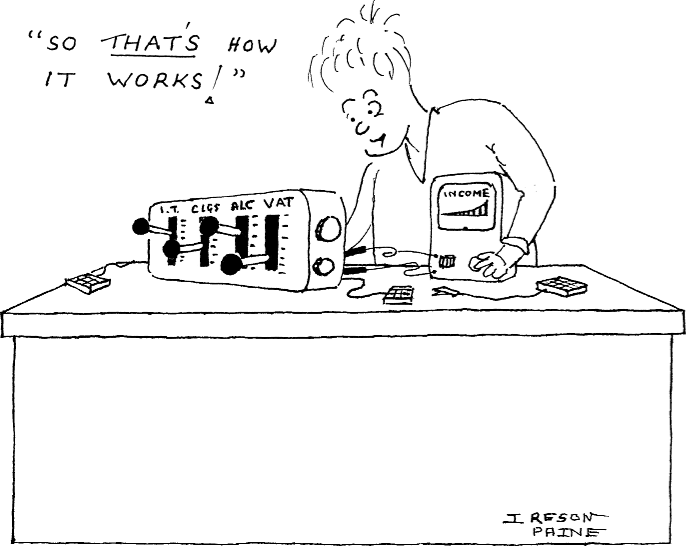R AND R-TAXBEN

Introduction
This slideshow is about a preliminary translation of a simulation of the UK economy from Python into R. The simulation is a "microeconomic" model, meaning that it simulates at the level of individual people. In contrast, a "macroeconomic" model (which this is not), would simulate bulk economic variables such as inflation and unemployment.
The model reads surveys of households, with their expenditure and income. To these, it applies rules describing the UK tax and benefits system. Users can change these via a front-end: for example, increase VAT on alcohol or decrease child benefit. Using the rules, it calculates how the changes would affect each household's net expenditure and income.
Introduction II
The model can use various different data sets. For our initial translation, we're concentrating on the Government's Family Resources Survey, which surveys 20,000 households each year. See "Introduction to the Family Resources Survey" for an overview of the 2013-2014 survey. This and other documentation, including details of the columns in the data tables, are available at the "Family Resources Survey, 2013-2014" data catalogue page.
Introduction III
Models like this can be used in various ways. One is evaluation of Government economic policy. If the Government increases income tax, how will this affect net incomes? Will it push a lot of low-income people into poverty? Or will it extract income mainly from the better off? To answer such questions, we need to summarise how change affects the population as a whole, via tools such as graphs of income distribution.
Another use is education: about economics, about policy, and about statistics and data analysis. I'll say more about this later. We believe it's an important application, where R will be very helpful.
Introduction IV: Credits
The work reported here was done in R version 3.4.2, mainly for Windows. I used various packages, not least Hadley Wickham's Tidyverse. Of which, I'll have a lot more to say.
The microsimulation model being translated was written by Landman Economics. Funding for this proof-of-concept was provided by Landman.
The R-Taxben logo was derived from the R logo, which is available under the Creative Commons Attribution-ShareAlike 4.0 International license (CC-BY-SA 4.0). It contains extra graphics surrounding the R logo, which has not itself been changed.
About This Presentation
I've designed this slideshow to be the closest thing I could make to a video or to one side of a conversation. So I've structured it as "fragments", each being like a sentence where I'm showing something new or amplifying something already shown.
To progress through the fragments, press the right-arrow control or right-arrow on the keyboard. Left-arrow will go backwards, unshowing fragments one by one. Clicking the browser background and typing O will toggle between the current slide and a strip view of all the slides. Clicking on the "contents" icon at top left will go to the contents page, slide 9.
Many slides contain screenshots. So that the text in them is legible, use the biggest screen you can find. I wrote this on a 23″ 1920×1080 pixel screen, with the browser window roughly 1270 pixels by 850 pixels.
About This Presentation II
There are two versions of this presentation. One, which I wrote for colleagues who don't know R, is the "fragments" one mentioned in the previous slide.
The other is a "non-fragments" one which allows quicker reading. It makes each slide come into view in one go. Its screenshots come into view with the rest of their slide, and are animated to cater for the fact that many of them scroll the R window, and hence can't be fitted into one image. To change views, use the links here, or those under the contents icon.
Before reading the slideshow, you may like to try my blog post at "R-Taxben: a Microsimulation Economic Model in R".
About This Presentation III: Credits
This presentation was written in Hakim El Hattab et. al.'s reveal.js. This is a JavaScript system for building web-based slideshows. A demonstration can be seen at revealjs.com .
The contents page was implemented with Frederick Feibel's Presentable plugin.
Contents
What Is R?
R is a programming language for statistics, with enough features to be useful for general-purpose progranmming as well.
R programs can be run from the command-line, from web servers, and from operating-system scripts. However, R can also be run interactively.
R makes it easy to examine data and track down errors and anomalies. Tools include histograms, functions for counting and categorising, and queries for sorting and filtering.
Why Use R?
R will (I hope) be able to program everything we need.
... including all the stats and graphics we could ever desire ...
... and the tools for tracking down errors and anomalies in data and results.
R will also (I hope) be fast enough.
R can be run from the web.
R has excellent packages for testing code.
R has an active user community, knowledgeable and approachable developers, and a lot of high-quality libraries.
Interactiveness will help users get a feel for R-Taxben and its data.
A Glimpse of R: Interaction

A Glimpse of R: Variables
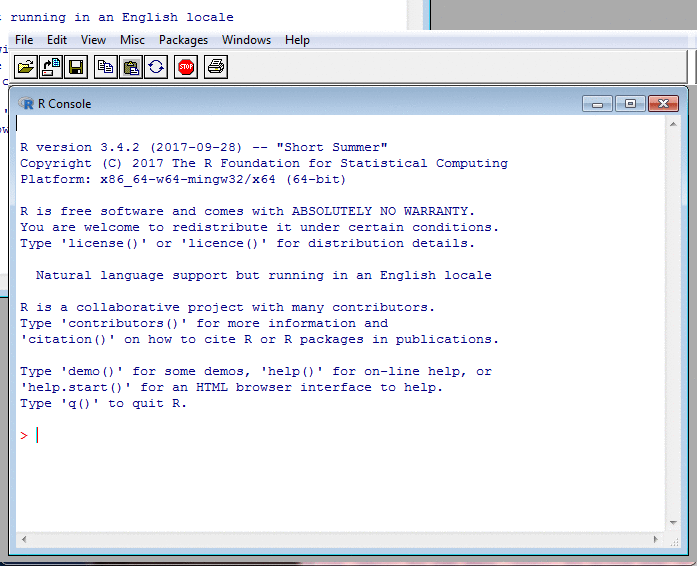
A Glimpse of R: Interaction II
In the screenshots, my input is in red.
The R prompt, >, is also in red,
but I never type that: R does.
R's other output is in blue.
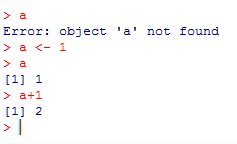
Sometimes, there is no output, such as after an assignment. But usually, R displays a result. This is preceded by a number in square brackets saying how many elements the result contains. That's because R treats even single numbers as vectors and so feels compelled to tell you how long these are.
A Glimpse of R: Interaction III
In these slides, when you click right arrow or press the right-arrow key, it displays a later version of the screenshot. Generally, this shows one more piece of input to R, and its result. So one more piece of red and one more piece of blue. Occasionally, it shows two pieces of input and the results.
In later screenshots, I may pause right after each input, so that you get the effect of typing a command and then seeing its result. That's useful when I'm demonstrating things like graphics where R pops up new windows. But I thought doing that everywhere would be annoying, because it needs you to click or press more often.
A Glimpse of R: Functions
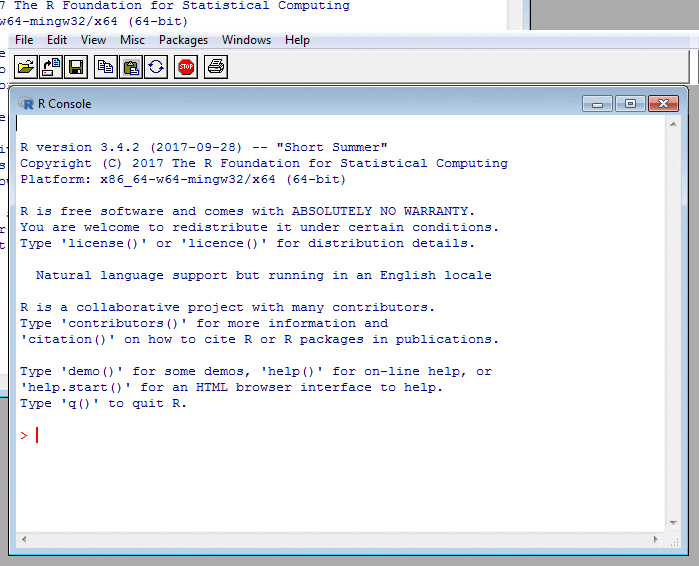
A Glimpse of R: Functions in Source Code
# Converts the year and month to a string
# of the form "2014-15" denoting the tax
# year starting in 'month' of 'year'.
# This function is vectorised.
#
year_and_month_to_tax_year <- function( year, month )
{
firstyear <-
ifelse( month <= 3, year-1, year )
tax_year <-
sprintf( '%04d-%02d', firstyear, ( firstyear + 1 ) %% 100 )
tax_year
}
A Glimpse of R: Datatypes

R: The Same but Different
So R has things that you'd find in other languages, including variables, functions, conditionals, Booleans and strings. But it also does some things slightly differently, and other things very differently.
Example of a slight difference: paste (previous slide)
for joining strings.
Example of a big difference: vectors (also previous slide).
These differences mean translating code literally from another language may not work, or work well. And we must beware of faux amis.
The R Inferno
Some differences between R and other
languages are so big that there is an entire book warning
programmers about them. The R
Inferno by Patrick Burns.

The R Inferno II
(The Dante’s Inferno ride entrance in Panama City, Florida: by
"Marktippin".)
So Again, Why Use R?
So if R is so weird, why use it? I've mentioned its excellent stats and graphics, its data-analysis tools, its interactivity, its tools for testing code, its libraries and user community. But it also has a datatype which matches the structure of our data. I claim that, together with interactivity, this will make the "things" that R-Taxben operates on seem more real to its users.
Reification
Programmers live their working lives surrounded by data structures and subroutines, entities that grow to become as concrete — as "thing-like", as "manipulable" — as teacups and bricks.
The feeling of thing-ness is strengthened, I believe, by interactive shells such as R’s which enable one to call functions and inspect their results, and to store these in variables and pass them around. For R-Taxben, those results are either chunks of economic data such as our tables of households, or income-distribution graphs and other summaries. I hope that being able to touch, probe, and pick up these things with R will make them seem more real.
Reification II
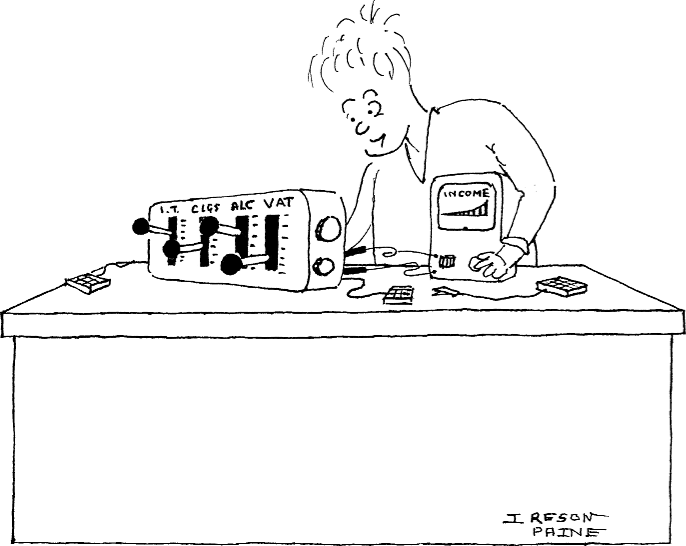
Educational Microworlds
Educational microworlds, non-threatening playgrounds where students learn by experiment, were popularised by Seymour Papert. He co-designed Logo, with which children learned mathematics by programming "turtles" to draw squares and other figures.
For an introduction, see Education Week's "Seymour Papert's 'Microworld': An Educational Utopia". There's a survey of Logo and other microworlds in Lloyd P. Rieber's "Microworlds". To quote: "However, another, much smaller collection of software, known as microworlds, is based on very different principles, those of invention, play, and discovery. Instead of seeking to give students knowledge passed down from one generation to the next as efficiently as possible, the aim is to give students the resources to build and refine their own knowledge in personal and meaningful ways."
Educational Microworlds II
"Logo is the name for a philosophy of education and for a continually evolving family of computer languages that aid its realization. Its learning environments articulate the principle that giving people personal control over powerful computational resources can enable them to establish intimate contact with profound ideas from science, from mathematics, and from the art of intellectual model building. Its computer languages are designed to transform computers into flexible tools to aid in learning, in playing, and in exploring." From Logo for the Apple II by H. Abelson, quoted in Rieber.
Educational Microworlds III: Can We Build an EconomicsLand?
"Similar to the idea that the best way to learn Spanish is to go and live in Spain, Papert conjectured that learning mathematics via Logo was similar to having students visit a comput- erized Mathland where the inhabitants (i.e., the turtle) speak only Logo. And because mathematics is the language of Logo, children would learn mathematics naturally by using it to communicate to the turtle. In Mathland, people do not just study mathematics, according to Papert, they 'live' mathematics." From Rieber, op. cit.
Towards R-Taxben: Data Frames
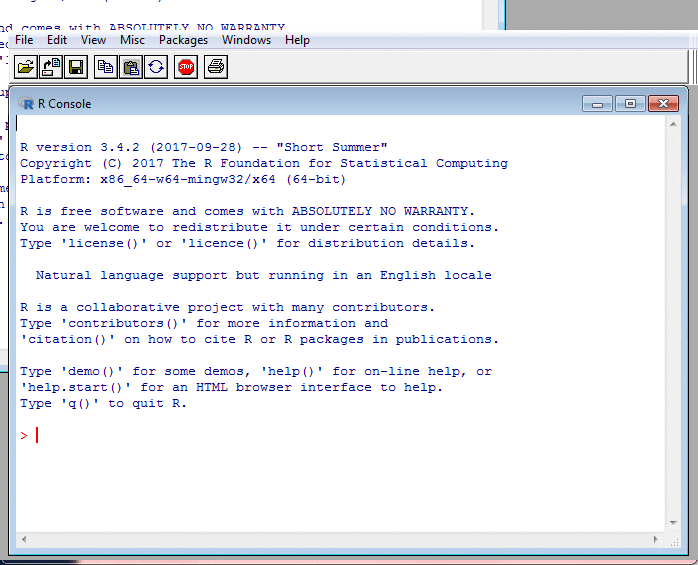
Data Frames, $, and Implicit Loops
In the last slide, hhs is a data frame. It's
like a database table. One column will usually be an ID or
some other key. Other columns will be stuff like incomes
and expenditures.
A fundamental part of R is the $ operator,
which selects a column.
We can make new columns from old, by assigning to them.
When doing so, there is implicit looping. The arithmetic gets applied to every row of the data frame, without us having to code a loop.
This implicit looping occurs elsewhere too, and is something new R programmers have to get to grips with.
Data Frames, Tibbles, and tribble
In my example's output, you see the word "tibble". Tibbles
are a modern version of data frames: more efficient, more
convenient, more adaptable. They're implemented by a package called
the Tidyverse, of which more later. I use them because
of their advantages. But they
are data frames, and fundamental data-frame stuff
like the $ operator will work with them.
Tibbles have a function called tribble, for
"transposed tibble". It enables small tibbles to
be input
a row at a time, and is useful for interactive demos like mine.
In my call to tibble, the tilde
gives the names of columns. This — how R handles names —
is another thing novices must get used to.
The Tidyverse
I said that tibbles are provided by a package called the Tidyverse. It's a big package, with lots of clever features for analysing and transforming data. I think it has advantages over the language and libraries you get by default, so I've decided to use it.
This means others working on R-Taxben would need to know it. Unfortunately, there are some ways in which it is very different from base R, and this can confuse learners. But, as I argue in "Should I Use the Tidyverse?", I believe it's still worthwhile.
Towards R-Taxben: Reading CSV Files

Towards R-Taxben: Reading CSV Files II
In the previous slide, I read a year's worth of real FRS households from a comma-separated values (CSV) file.
Displaying such large amounts of data without
flooding the screen can be tricky.
I used R's built-in data viewer, invoked with
the View function, to look at
them.
I also used some Tidyverse query functions,
filter and select,
to display three columns from the first
nine households.
Toward R-Taxben: Probing Data
R, and the Tidyverse, provide lots of tools for investigating data. I shall demonstrate in the next few slides. They are often remarkably concise.
Probing Data: Histograms
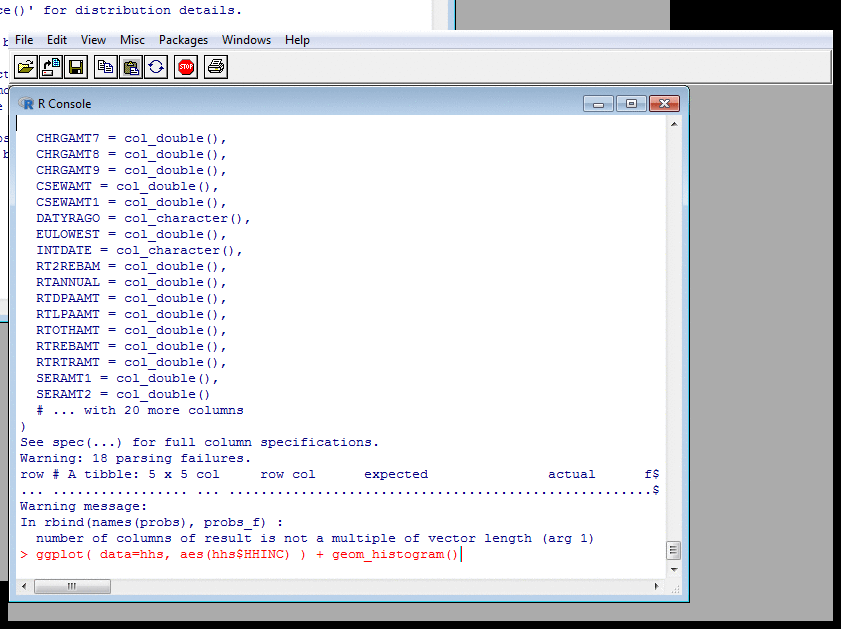
Probing Data: Histograms II
The ggplot function, from the Tidyverse,
generates publication-quality plots. That example
starts with the FRS households already loaded into
the hhs variable.
I plotted a histogram of gross household income with
the default style and axes and number of bins, then
adjusted the X-axis scale and number of bins, and then
made the colours more appealing.
Probing Data: Scatterplots
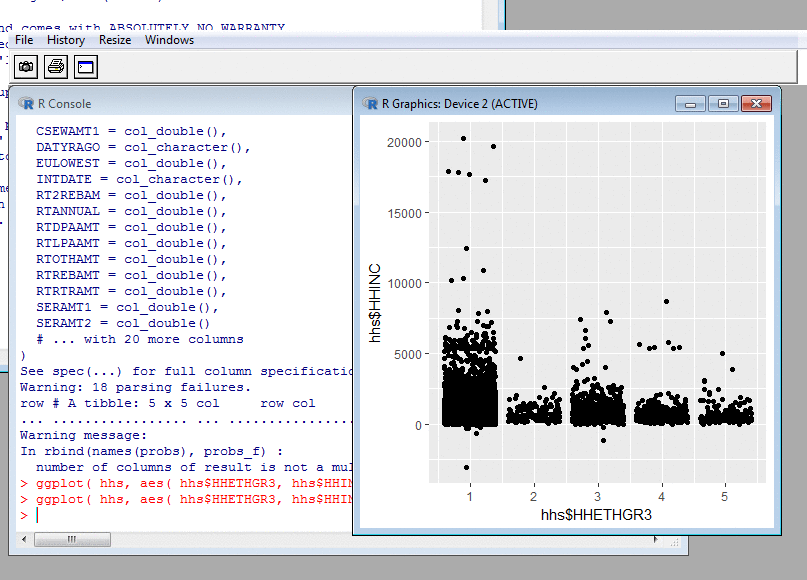
Probing Data: Scatterplots II
The last example starts by plotting gross income HHINC against ethnic group, HHETHGR3. The latter is a discrete variable, coded as white=1, mixed=2, Asian=3, black=4, other=5. Consequently, there are only five X values, and the plot consists of five broken vertical lines.
In each line, points with the same income lie on
top of one another, so there's no way to see how many
people in each ethnic group have the same income. So
my second plot adds "jitter", randomly displacing
each point by a small amount so that it doesn't
overlap its fellows. With the features provided
by ggplot, this was no harder than
plotting the histogram and the original scatterplot.
Probing Data: Violin Plots
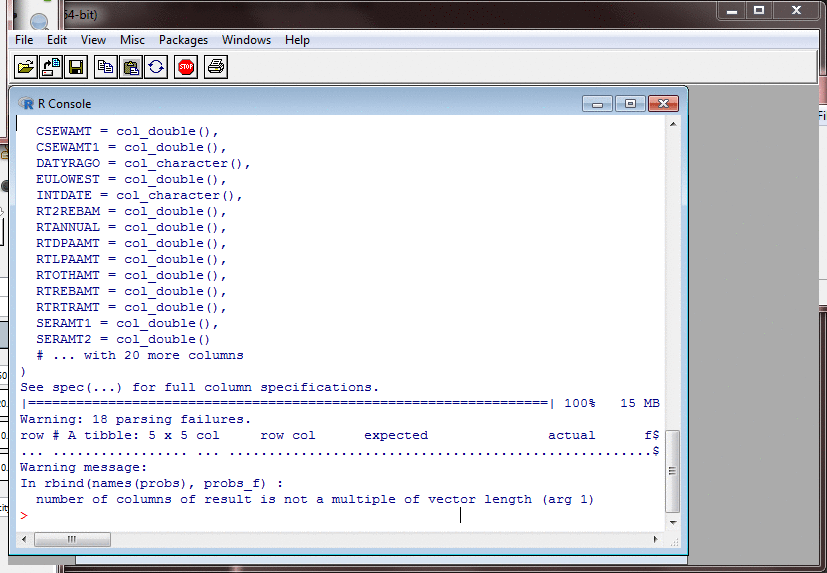
Probing Data: Violin Plots II
A violin plot looks like a histogram glued to
its reflection, and is a handy way of showing
the density of points. These too can be generated by
ggplot.
However, this wasn't quite as easy as for
scatterplots. We don't need one violin plot overall, but
one for each ethnic
group. To make ggplot do this, I converted
the ethnic-group variable from an integer to a "factor". That's a kind of
label or name that R uses for categorical variables. ggplot
then knew to plot one violin for each category.
Probing Data: Violin Plots III
The plots I made are normalised so that each violin has the same width, regardless of how many points it contains. But there is an option to make violin width increase with points. This gives an immediate idea of the size of the group, but makes it harder to compare the group's distribution with that of other groups. Part of our job will be to choose the most useful options for the data-exploration tools we give users.
Probing Data: More Complicated Plots
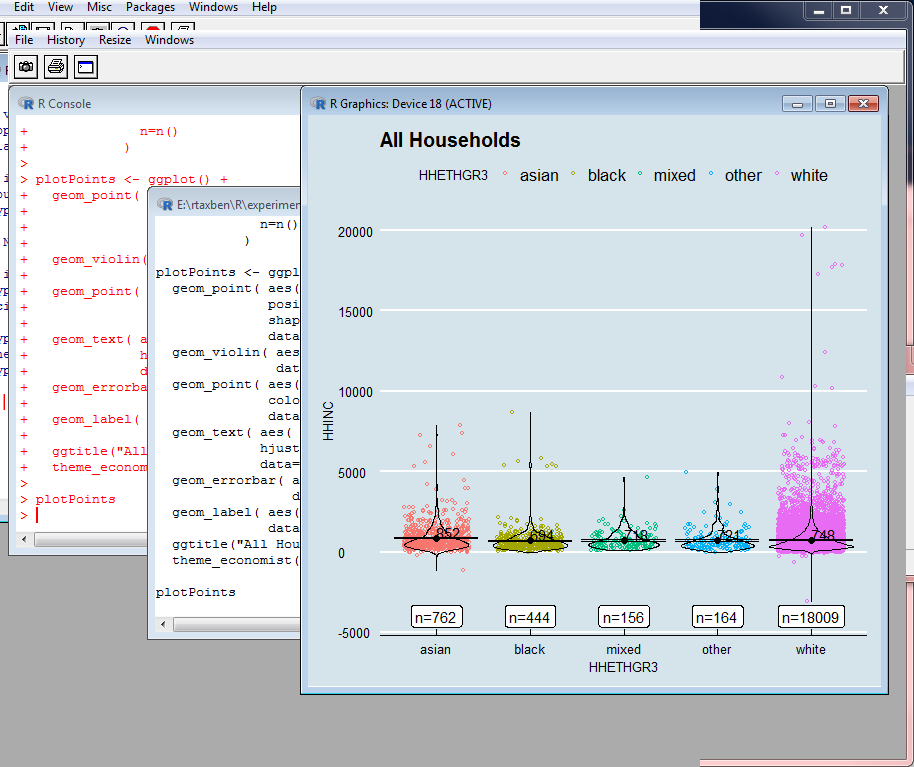
Probing Data: More Complicated Plots II
# try_plots_2.R
#
# Makes nice plots of income against
# ethnicity for the FRS households
# data. Each ethnicity group's income
# is plotted as a jittered scatterplot
# with violin plot overlaid, plus a
# dot showing the mean income, errorbars
# showing the standard deviation, and a
# label showing the size of the group.
# This is a version of try_plots.R
# adapted for my Reveal presentation.
library( tidyverse )
hhs <- read_csv('data/FRS201415AllData/househol.csv')
source( 'coding_frames.R' )
ethnicity_codes <- coding_frame(
1 , 'white',
2 , 'mixed',
3 , 'asian',
4 , 'black',
5 , 'other'
)
hhs$HHETHGR3 <- recode_with_coding_frame( hhs$HHETHGR3, ethnicity_codes
)
hhsSummary <- hhs %>%
group_by( HHETHGR3 ) %>%
summarise( hhinc_mean = mean(HHINC),
hhinc_se = sqrt( var(HHINC) / length(HHINC) ),
n=n()
)
#
# Groups households by ethnic group,
# then works out the mean and standard
# deviation of income in each group.
library( ggthemes )
#
# This library contains a theme that
# imitates The Economist's style.
plotPoints <- ggplot() +
geom_point( aes( x=HHETHGR3, y=HHINC, color=HHETHGR3 ),
position = position_jitter( width=0.35, height=0.0 ),
shape=21, size=1,
data=hhs ) +
# Scatterplots, with jitter.
geom_violin( aes( x=HHETHGR3, y=HHINC, color=HHETHGR3 ),
color='black', fill='white', alpha=0.0,
data=hhs ) +
# Violin plots.
geom_point( aes( x=HHETHGR3, y=hhinc_mean ),
colour="black", size=2,
data=hhsSummary ) +
# Points showing the means.
geom_text( aes( x=HHETHGR3, y=hhinc_mean,
label=as.integer(hhinc_mean) ),
hjust=0, vjust=0,
data=hhsSummary ) +
# Text showing the mean in numbers.
geom_errorbar( aes( x=HHETHGR3, ymin=hhinc_mean-hhinc_se,
ymax=hhinc_mean+hhinc_se ),
data=hhsSummary ) +
# Errorbars showing the standard deviations.
geom_label( aes( x=HHETHGR3, y=-4000,
label=str_c("n=",as.integer(n)) ),
data=hhsSummary ) +
# Labels showing the sizes of groups.
ggtitle("All Households") +
theme_economist()
plotPoints
Probing Data: More Complicated Plots III
The two previous slides show a more ambitious plot, and the complete program that produced it. I will say more about the latter later, but I want you to see how short it is.
The first part of the code reads our households, and then recodes the HHETHGR3 ethnicity field to meaningful names rather than numbers. This uses a coding-frame library that I wrote.
It then calculates the mean and standard deviation of income within each ethnicity group.
Probing Data: More Complicated Plots IV
The rest of the program does the plotting. It depicts each group as a scatterplot with jitter, overlaid with a violin, shown as boundary only in order not to hide what's underneath. There is also a black dot showing the mean, with numerical annotation, and a label showing the size of each group.
These plots are built up in layers. So there's one layer for the scatterplot, one for the violin, one for the dot, and so on.
To put icing on the cake, we use a theme that imitates the style used by "The Economist"!
Educational Microworlds IV
I got the idea of using HHETHGR3 in my plotting demonstrations from "SC504: Statistical Analysis: ASSIGNMENT ONE: Spring 2008" at http://orb.essex.ac.uk/hs/hs927/assignment_1(SOC).doc. This is an assignment for sociology students in the Essex University School of Health and Social Care.
With my examples, this demonstrates how educational even the raw FRS data can be, if the student is equipped with the right tools. We should think about that as something R-Taxben has to offer.
Probing Data: Counting, Summing, Averaging
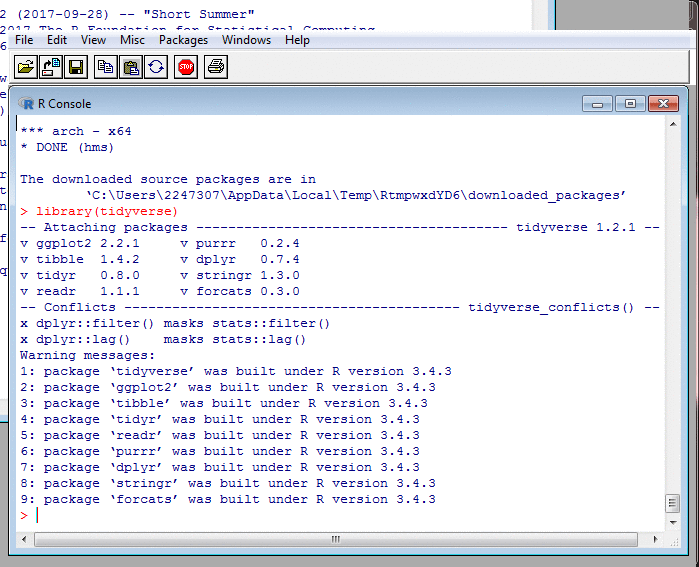
Probing Data: Counting, Summing, Averaging II
R treats columns of data frames as vectors. So
numbers$x is a vector of as many numbers as there are
rows. The functions I called know it to be
a vector, and loop over it,
counting, summing or averaging elements.
As I've indicated before, this economy of notation
is useful but can also confuse.
The expression sum( numbers$x )
is the sum of all elements and returns one number.
But numbers$x / 10 would divide each element by 10,
returning a number for each. This is a problem with making things (such
as looping) implicit, and is
one reason for
The R Inferno.
Probing Data: Summarising
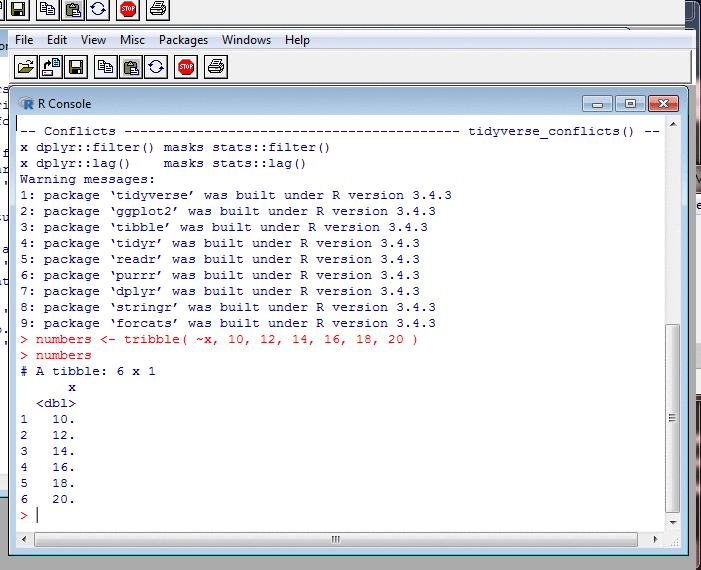
Probing Data: Summarising II
Whereas the "Counting, Summing, Averaging" example was base R, this one
calls the Tidyverse summarise function. This looks
rather like the mutate which I'll talk about about
in the following section on transforming data. It's a set
of equations that generates a new data frame.
But instead of this
having as many rows as the old one, it has fewer, because its
cells contain aggregated values. Here, it has one row, but see the next
slide for cases where it has more. The aggregating functions are
on the right of the = sign.
The new data frame can have more than one column. The last bit of the example shows this, where I calculate count, total and average in one go.
Probing Data: Summarising and Grouping
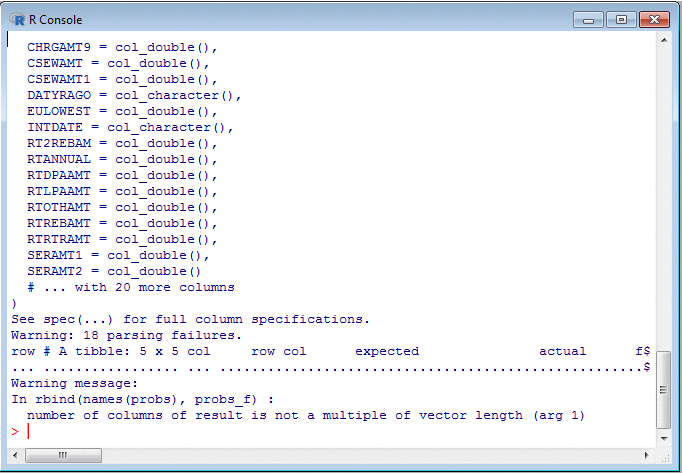
Probing Data: Summarising and Grouping II
This output shows the data frame I plotted the "more complicated plot" from, the The Economist-style one with a scatterplot and violin for each ethnic group. This follows the same principles as before. But now, there's grouping. The expression separates the input data frame into groups of rows, one for each value of HHETHGR3. It then treats each group separately, applying the aggregation functions to each. The data frame it returns has one row for each of those groups.
Probing Data: Multi-level Grouping
| SERNUM | BENUNIT |
|---|---|
| 1 | 1 |
| 1 | 2 |
| 2 | 1 |
| 2 | 2 |
| 2 | 3 |
| 3 | 1 |
| 4 | 1 |
| 4 | 2 |
| 5 | 1 |
| 5 | 2 |
| 6 | 1 |
| SERNUM | Count of BENUNITs |
|---|---|
| 1 | 2 |
| 2 | 3 |
| 3 | 1 |
| 4 | 2 |
| 5 | 2 |
| 6 | 1 |
| Count of BENUNITs | How often this count occurs |
|---|---|
| 1 | 2 |
| 2 | 3 |
| 3 | 1 |
Probing Data: Multi-level Grouping II
# try_counting_benefit_units_2.R
#
# This arose from my wanting to check
# joins between household records and
# benefit-unit records. Most joins
# seemed to be 1:1, and I wanted to see
# what proportion of households did
# in fact have only one benefit unit.
# This is a version of
# try_counting_benefit_units.R adapted
# for the Reveal presentation.
library( tidyverse )
bus <- read.csv( "data/FRS201415AllData/benunit.csv" )
bus %>%
group_by(SERNUM) %>%
summarise( n=n() )
#
# Show how many times
# each SERNUM occurs:
#
# A tibble: 19,535 x 2
# SERNUM n
#
# 1 1 1
# 2 2 1
# 3 3 1
# 4 4 1
# 5 5 1
# 6 6 1
# 7 7 1
# 8 8 1
# 9 9 1
# 10 10 1
# ... with 19,525 more rows
bus %>%
group_by(SERNUM) %>%
summarise( n=n() ) %>%
group_by(n) %>%
summarise( nn=n() )
#
# Count the number of 1's, 2's etc. in the
# n column above:
#
# A tibble: 7 x 2
# n nn
#
# 1 1 16813
# 2 2 2105
# 3 3 500
# 4 4 88
# 5 5 20
# 6 6 8
# 7 7 1
bu_counts <- bus %>%
group_by(SERNUM) %>%
summarise( n=n() )
#
# Assign to a variable so I can histogram it.
ggplot(bu_counts, aes(x = n)) +
geom_histogram(binwidth=1,
col="red",
fill="green",
alpha = .2) +
xlab( 'BENUNITs per household' ) +
ylab( 'Frequency' )
#
# Make the binwidth 1: the default turns out to
# be 30.
ggsave( "bu_counts.png" )
ggplot(bu_counts, aes(x = n)) +
geom_histogram(binwidth=1,
col="red",
fill="green",
alpha = .2) +
xlab( 'BENUNITs per household' ) +
ylab( 'Frequency' ) +
scale_y_continuous(trans='log2')
#
# Make y logarithmic so I can see frequencies
# for the larger counts. These are too small
# to show up on a linear scale.
ggsave( "log_bu_counts.png" )
Probing Data: Multi-Level Grouping III


Probing Data: Multi-Level Grouping IV
We can group and summarise more than once. In the FRS data, each household holds one or more benefit units: an adult plus spouse if any, plus children. We have a data file for these, with one record per unit per household. My database JOINs seemed to find some households with a surprisingly large number of units, so I wanted to check their distribution.
So I did as on the first two slides. I grouped by SERNUM, the household ID, and counted the records per group. That returned a data frame with one record per household, holding a field saying how many benefit units the household had. I grouped the results by that field and counted the records in each group. That gave another data frame with one row for each count, and a column for how many times that count occurred.
Probing Data: Multi-Level Grouping V
The histograms on the third multi-level grouping slide were generated from the table of household ID (SERNUM) versus number of benefit units. This was only the first level of grouping, so strictly speaking, I shouldn't show them here. But they are closely related, and I'm also showing them because I want to keep promoting R for data analysis. The plotting code is at the end of the second slide.
The first histogram shows the distribution of benefit units per household, with the default linear Y-axis. To make all bins more visible, I plotted again with a logarithmic Y-axis, giving the second histogram. The distribution is amazingly regular. Chance, or some strange law?
Probing Data: Multi-Level Grouping Found a Bug
Here's a practical illustration of the power of this technique. We had a typo in our date handling, which was causing some households to be allocated to a tax year one off from that they should have had. Using grouping and counting, I could very quickly count the households that fell under various years, and check whether the totals were plausible. They weren't, and that led me to the bug.
Toward R-Taxben: Transforming Data
All these tools for probing data are useful for me and other programmers checking for bugs and validating data. And, of course — this is R-Taxben's rationale, after all — for modellers and students.
I have shown how useful they can be even when applied to the original FRS files. But the model actually transforms those files into forms more useful to it. Let's now look at the tools I use for these transformations.
Transforming Data: Filtering Rows
I showed this in the slide on reading CSV files. The expression
hhs %>% filter( SERNUM < 10 )
returns
a data frame with only those rows whose SERNUM field
is less than 10.
There are base-R features for keeping and discarding rows, but this is the Tidyverse way, which is simpler.
Transforming Data: Selecting Columns
I showed a Tidyverse technique for this too. This expression:
hhs %>% select( SERNUM, ADULTH, HHINC )
returns a data frame with only the three columns named.
FRS files have lots of columns that we don't
need. So one reason R-Taxben selects columns is to
throw away those it won't use. Actually, I don't
use select for that. The function I
call to read CSV files can be told to keep only
certain columns, so I select them there.
But there are other reasons to select. One is that we may produce new columns to hold intermediate results, then discard those when finished with. I do that in several places.
Transforming Data: New Columns From Old
I demonstrated this when discussing data frames. The assignment:
hhs$weekly_income <- hhs$income / 52
makes a new column whose values are the income divided by 52.
Transforming Data: mutate
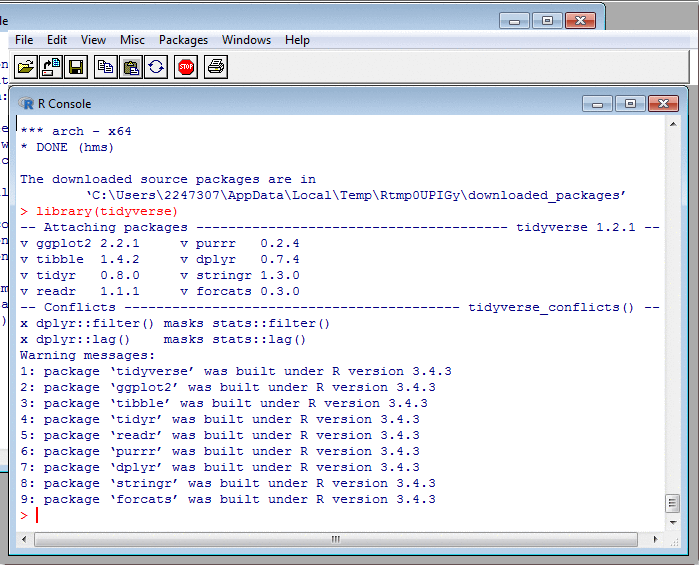
Transforming Data: mutate II
This once more is a Tidyverse technique. It feels different from using $ and assignment, because it encourages us to collect all the column-creation code in one place, like a set of equations.
This is good. In base R, if creating a new column, you could have assignments to it all over the place, perhaps separated by many many pages. Such code is incredibly hard to read. Much better to mention the target column just once, so that anyone reading the code knows they needn't look anywhere else for it. (It's the same argument for why labels and goto's are bad.) After some consideration, I've decided to adopt this single-target style wherever possible.
A Single-Target Style for Files Too
Although I've given examples of transforming households, there are many other kinds of FRS file. To mention but a few: data on jobs; pension provision; house purchases; renting; mortgages; and benefits. I'm applying the single-target principle to files as well as columns of files.
So I transform each file in a separate module. Such code is easier to read and maintain, because it groups related things together. Sometimes, it makes more work. If a person in a household has several jobs, I must aggregate the salaries, add them to the salaries for other people in the household, and then move the total upwards from job level to household level to store there. But on balance, I think the bother is worth it. The next slide shows a first version of the top-level code, reading files, transforming, and combining.
A Single-Target Style for Files Too II
# read_and_translate_frs.R
#
# I've tried reading FRS data before.
# But this is my latest idea on how to
# do it cleanly, after coding stuff to
# read and convert a number of FRS
# data files, and also after thinking
# about some of the topics I've blogged.
library( tidyverse )
source( 'read_frs_data_from_csv.R' )
source( 'accounts_to_incomes.R' )
source( 'benefits_to_incomes.R' )
source( 'pension_provisions_to_adult.R' )
source( 'adults_to_mod_adults.R' )
source( 'mortgages_to_mod_hh_fields.R' )
source( 'owners_to_mod_hh_fields.R' )
source( 'renters_to_mod_hh_fields.R' )
source( 'hhs_to_mod_hhs.R' )
# Generates mod_hh records and mod_adult
# records by reading and translating the
# appropriate data files, then nests
# the adults inside the households.
#
data_to_nested_mod_hhs <- function( params, frs_start_year )
{
mod_hhs <- data_to_mod_hhs( params, frs_start_year )
# mod_bus <- data_to_mod_bus()
# TO DO: write this.
mod_ads <- data_to_mod_ads( frs_start_year )
joined <- full_join( mod_hhs
, mod_ads
, by="sernum"
)
mod_hh_field_names <- names( mod_hhs )
nested <- nest( joined, - !! (mod_hh_field_names), .key=adults )
nested
}
# Generates mod_hh records by reading
# and translating the appropriate data files.
#
data_to_mod_hhs <- function( params, frs_start_year )
{
hhs <- datafile( 'househol' ) %>%
read_frs_households_from_csv
#
# Passed to renters_to_mod_hh_fields() ,
# which is why I make it an intermediate
# variable.
mod_hhs_1 <- hhs %>%
hhs_to_mod_hhs( params, frs_start_year )
mod_hhs_mortgage_fields <- datafile( 'mortgage' ) %>%
read_frs_mortgages_from_csv %>%
mortgages_to_mod_hh_fields
mod_hhs_owner_fields <- datafile( 'owner' ) %>%
read_frs_owners_from_csv %>%
owners_to_mod_hh_fields
mod_hhs_renter_fields <- datafile( 'renter' ) %>%
read_frs_renters_from_csv %>%
renters_to_mod_hh_fields( hhs )
mod_hhs <- full_join( mod_hhs_1
, mod_hhs_mortgage_fields
, by="sernum"
) %>%
full_join( mod_hhs_owner_fields
, by="sernum"
) %>%
full_join( mod_hhs_renter_fields
, by="sernum"
)
mod_hhs
}
# Generates mod_adult records by reading
# and translating the appropriate data files.
#
data_to_mod_ads <- function( frs_start_year )
{
income_fields <- data_to_income_fields()
other_fields <- data_to_other_mod_ad_fields( frs_start_year )
mod_ads <- full_join( income_fields
, other_fields
, by=c("sernum","persnum")
)
mod_ads
}
# Generates the per-adult income fields
# that will form the incomes part of a
# mod_adult record. These have sernum
# and persnum as key fields.
#
data_to_income_fields <- function()
{
accounts_income_fields <- datafile( 'accounts' ) %>%
read_frs_accounts_from_csv %>%
accounts_to_incomes
benefits_income_fields <- datafile( 'benefits' ) %>%
read_frs_benefits_from_csv %>%
benefits_to_incomes
income_fields <- full_join( accounts_income_fields
, benefits_income_fields
, by=c("sernum","persnum")
)
#
# TO DO: Puts NA for fields where one of
# the records is missing. Must check that
# those records are actually not there
# (why would someone not have benefit info?),
# and fill with zeros.
income_fields
}
# Generates the per-adult non-income fields
# that will form part of a
# mod_adult record. These have sernum
# and persnum as key fields.
#
data_to_other_mod_ad_fields <- function( frs_start_year )
{
adult_fields <- datafile( 'adult' ) %>%
read_frs_adults_from_csv %>%
adults_to_mod_adults( frs_start_year )
penprov_fields <- datafile( 'penprov' ) %>%
read_frs_pension_provisions_from_csv %>%
pension_provisions_to_adult
mod_ad_fields <- full_join( adult_fields
, penprov_fields
, by=c("sernum","persnum")
)
mod_ad_fields
}
datafile <- function( filename )
{
paste( "data/FRS201415AllData/", filename, ".csv", sep="" )
}
Transforming Data: mutate III
# adults_to_incomes.R
#
# Converts adult records into incomes.
library( tidyverse )
source( 'our_coding_frames.R' )
adults_to_incomes <- function( ads, frs_start_year )
{
income <- ads %>%
transmute( sernum = SERNUM
, persnum = PERSON
# This uniquely identifies an adult
# within a household (I hope), and
# will be used when linking
# adult records with pension ones.
, access_fund = ifelse( ACCESS == 1, ACCSSAMT, 0 )
# Access-fund money.
, ema = ifelse( ADEMA == 1, ADEMAAMT, 0 )
# EMA money.
, allowance = ifelse( ALLOW1 == 1, ALLPAY1, 0 ) +
ifelse( ALLOW2 == 1, ALLPAY2, 0 )
, maintenance = ifelse( ALLOW3 == 1, ALLPAY3, 0 ) +
ifelse( ALLOW4 == 1, ALLPAY4, 0 ) +
ifelse( MNTAMT1 > 0, MNTAMT1, 0 ) +
ifelse( MNTAMT2 > 0, MNTAMT2, 0 )
#
# Allowances: note that allpay3 and allpay4,
# which are clearly payments for children,
# have been placed in the 'maintenance' slot.
# This makes it easier to disregard
# maintenance and allowance payments for
# children for UC and IS but not payments
# for adults.
#
# If maintenance is paid via DWP, this may
# affect the amount of benefits received if we
# are using FRS data on benefit receipts.
, spouse_allowance = ifelse( APAMT > 0, APAMT, 0 ) +
ifelse( APDAMT > 0, APDAMT, 0 )
, grants = ifelse( GRTAMT1 > 0, GRTAMT1, 0 ) +
ifelse( GRTAMT2 > 0, GRTAMT2, 0 )
, property = ifelse( ROYYR1>0 & RENTPROF==1, ROYYR1, 0 )
#
# Property income (net). Note losses are
# possible here. We store these in a different
# place, the mod_adult, from property gains.
, royalties = ifelse( ROYYR2>0, ROYYR2, 0 )
# Royalties.
, sleeping_partner = ifelse( ROYYR3>0, ROYYR3, 0 )
# Sleeping partner.
, overseas_pension = ifelse( ROYYR4>0, ROYYR4, 0 )
# Overseas pension.
, self_employment = ifelse( SEINCAM2 >= 0, SEINCAM2, 0 )
, se_losses = ifelse( SEINCAM2 < 0, -SEINCAM2, 0 )
# We store losses as a positive number,
# so if SEINCAM2 is negative, we need
# to _subtract_ it.
)
income
}
Transforming Data: mutate IV
A real-life use of mutate is shown
on the previous slide. Actually, it's a
variant of mutate called
transmute, but the idea is the same.
This is from my code which extracts various
kinds of income from FRS data
about individual adults.
And the next slide shows another use. You see a view of the first few lines of a raw FRS households file, a view of them after transformation into a more convenient form, and the code that transforms them.
Transforming Data: mutate V
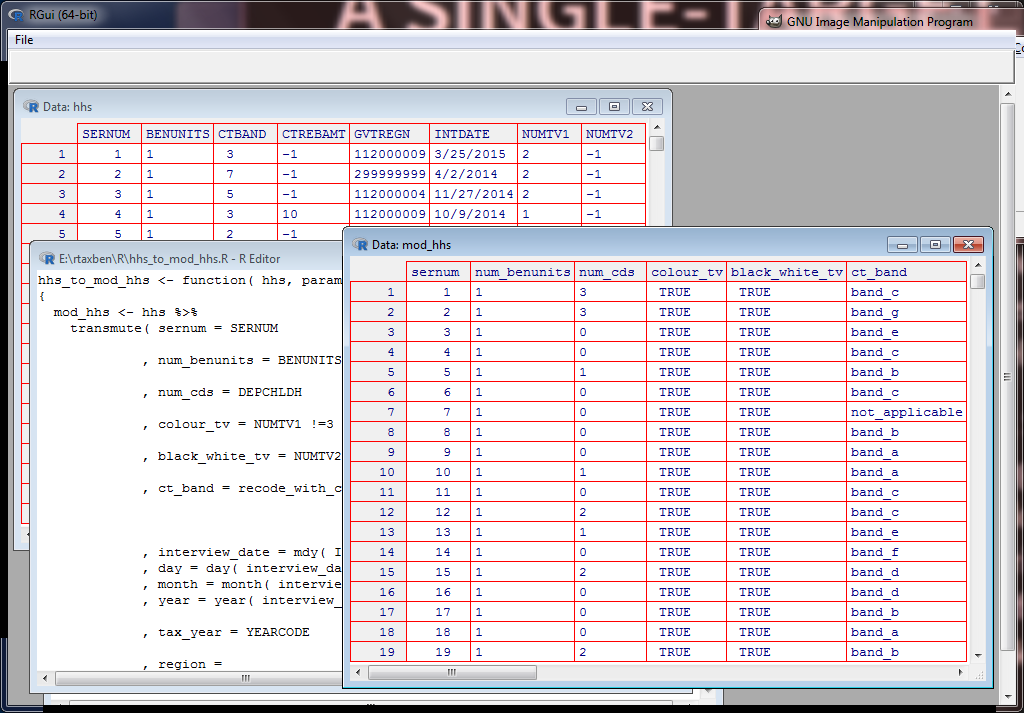
Transforming Data: Filtering, Splitting, and Mutating
# mortgages_to_mod_hh_fields.R
#
# Calculates a mod_household's
# outstanding_mortgage,
# mort_interest, and mort_payment
# fields.
library( tidyverse )
library( assertthat )
mortgages_to_mod_hh_fields <- function( mortgages, params )
{
# This function separates mortgages into two
# sets: repayment mortgages, for which INTPRPAY > 0;
# and interest-only mortgages, for which MORINPAY > 0.
# In the repayment mortgages, interest is calculated from
# payment, but in the interest-only mortgages, payment is
# calculated from interest. The data flows in opposite
# directions, which makes these hard to implement inside
# a single mutate. That's why I've split them into the
# two sets, which I process separately and then recombine
# the results from. This may not be the most efficient
# method, but I can optimise once we've tested it and
# I'm sure I have the logic right.
assert_that( ! any( mortgages$INTPRPAY > 0 & mortgages$MORINPAY > 0 ) )
#
# The 2014-15 data (on which I developed this code)
# doesn't have any mortgages where both these fields
# are greater than 0. But check anyway, for the benefit of
# other data sets. If we find such data, we either have
# to decree it invalid, or modify this function.
per_repayment_mortgage_fields <- mortgages %>%
filter( INTPRPAY > 0 ) %>%
repayment_mortgages_to_per_mortgage_fields( params )
per_interest_only_mortgage_fields <- mortgages %>%
filter( MORINPAY > 0 ) %>%
interest_only_mortgages_to_per_mortgage_fields
per_mortgage_fields <-
bind_rows( per_repayment_mortgage_fields
, per_interest_only_mortgage_fields
)
per_hh_fields <- per_mortgage_fields %>%
group_by( sernum ) %>%
summarise( mort_interest=sum( mort_interest )
, mort_payment=sum( mort_payment )
, outstanding_mortgage = sum( outstanding_mortgage )
) %>%
ungroup()
per_hh_fields
}
repayment_mortgages_to_per_mortgage_fields <- function( mortgages, params )
{
per_mortgage_fields <- mortgages %>%
transmute( sernum = SERNUM
, mort_payment = INTPRPAY
, years_to_run = MORTEND
, outstanding = MORTLEFT
, interest_rate = getp( params, mortgage_rate, year, month )
, mort_interest = calc_mortgage_interest( mort_payment,
years_to_run,
outstanding,
interest_rate )
, outstanding_mortgage = outstanding
)
per_mortgage_fields
}
interest_only_mortgages_to_per_mortgage_fields <- function( mortgages )
{
assert_that( ! any( mortgages$MORINUS == 1 & mortgages$MORUS > 0 ) )
#
# The case_when below assumes these two
# conditions are distinct, so check that
# this holds.
per_mortgage_fields <- mortgages %>%
transmute( sernum = SERNUM
, mort_interest = case_when( MORINUS == 1 ~ MORINPAY
, MORUS > 0 ~ MORUS
, TRUE ~ 0
)
, mort_payment = mort_interest
, outstanding_mortgage = 0
)
per_mortgage_fields
}
Transforming Data: Filtering, Splitting, and Mutating II
There are places in the model where it seems convenient to separate data into different sets of rows, process each in its own way, and then recombine them. The code on the previous slide is one of these. The FRS data has two kinds of mortgage: repayment, and interest-only. Payments and interest are calculated in very different ways.
That code is some of the most complex I've shown so far. It uses grouping and summarising and recoding, which I've not yet discussed. But here, the filtering and splitting is the point.
Transforming Data: Filtering, Splitting, and Mutating III
The design of R means we may filter and split where in other languages, we'd use conditionals. The loop "for each row R, if row is type A, process as A, else process as B" may be better written as "Split rows into type A and type B, process each, then recombine". There are strangenesses about how R's implicit looping interacts with conditional expressions that don't make such a decision straightforward. It needs careful thought about timing, about whether arguments are single items or entire column vectors, and about how much implicit looping R is doing.
Transforming Data: Summarising
The summarise function is great for
probing data. But sometimes, we need it for transformation too.
As already mentioned, our transformed households
contain the sum of salaries of all wage-earners in
the household. I use summarise
for that.
The function can also be used for things we wouldn't normally
think of as aggregation. As well as summing a
household's salaries,
we need to store a list of them in the household.
The R function list collects items into
lists: by passing that to summarise,
we can list all the items in a group.
Transforming Data: Recoding
Many FRS variables are numbers but represent discrete attributes such as sex. So to make our transformed data more readable, we must recode them as strings. I've implemented a "coding frames" library, which lets translation tables be defined and used as if they were Python dictionaries. I gave an example for the HHETHGR3 histograms when demonstrating plotting.
Actually, strings are not the best way to represent discrete
attributes. That's because R won't check for
rubbish such as mal, hemale,
or 08bnv-6b)%)$*%=856
being assigned to them. Bad stuff can get into the program and you
won't notice.
I need to think about this: other
kinds of value, such as R "factors" (which I mentioned when doing violin
plots), may be better.
Transforming Data: Spreading and Gathering
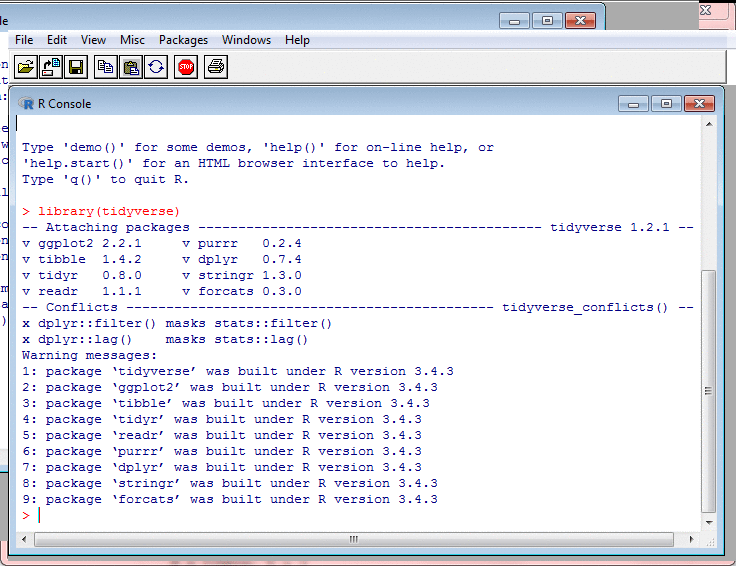
Transforming Data: Spreading and Gathering II
To "spread", in the Tidyverse, is to transform
a long narrow table to a short wide one. Given
a column of values and another column which
associates a type with each value, spread
makes a new column for each type, and puts each
type's values into its column.
I use spread to classify incomes into
different categories. It is very convenient that this
can be done by just one function.
There is a gather function which
undoes spread. It takes a table with
columns for different types of value, and merges
these into one column.
Transforming Data: Nesting
Nesting, yet another Tidyverse feature, makes it possible to put data frames into the cells of other data frames. I shan't demonstrate, as there isn't a good way to display nested tables. But they may be useful.
For example, households are composed of benefit units: an adult plus spouse if any, plus children. And benefit units are composed of adults. (And children, but they're less important.) My code may be easier to write and read if I store adults inside benefit units inside households, rather than as separate tables to be JOINed. It may make "uprating" easier, where we traverse tables updating money values to account for inflation.
Representation-Independent Selectors
|
|
||||||||||||||||||||||||||||||||||||||||
|
|
Representation-Independent Selectors II
"In the early stages of NIPY development, we focus on functionality and usability. As NIPY progresses, we will spend more energy on optimizing critical functions. There are many good options, including standard C-extensions. However, optimized code is often less readable and more difficult to debug and maintain. When we do optimize, we will first profile the code to determine the offending sections, then optimize those." Abridged from http://nipy.org/nipy/devel/guidelines/optimization.html .
"First make it work. Then make it right. Then make it fast." Attributed to Kent Beck.
"We should forget about small efficiencies, say about 97% of the time: premature optimization is the root of all evil." Donald Knuth.
Representation-Independent Selectors III
"When you start development, you have an early stage where you need to explore possibilities. You don't yet know the best approach, but have some ideas. If during that stage you go big looking for THE piece of code that will fit the problem perfectly, you will spend a considerable amount of time on that quest. You have too many uncertainties. So you need to experiment to reduce those uncertainties, so you can focus and implement your code. This experimentation process is the Make it Work stage, where you just code to achieve the desired behavior or effect." Abridged from http://henriquebastos.net/the-make-it-work-make-it-right-make-it-fast-misconception/ .
Representation-Independent Selectors IV
So when we begin coding, we must experiment to find more about possible solutions. Near the end of coding, we may need to optimise. But experiment and optimisation can both mean big changes to data structures. Some of these are made possible by nesting; and as the first slide shows, there are many ways to store the same information.
But when we change how data is stored, we don't want to change all the code that accesses it! Which we would if we relied on $ and column names: consider how different the expressions would be for retrieving Bob's benefits in each of the four layouts on the first slide.
Representation-Independent Selectors and Model Parameters
This applies not only to household data, but to the "parameters" that drive the model. These describe the taxes, and include stuff like VAT rates on a vast range of goods.
The Python version stored different parameters differently. Some to be accessed via subscripting with strings; some via subscripting with integers; some via dictionary keys. Change storage, and you'd have to update all the access code.
Representation-Independent Selectors V
My solution rests on two things. First, do all accesses
via functions that I define, rather than via $
and column names. Then if I ever change the storage, I can update
those functions accordingly. This provides an interface to
data that's
independent of its representation.
Second, R and the Tidyverse provide features for changing how the language processes the arguments to functions. With these, we can make string subscripts look like column names. This hides the differences between different kinds of selector. So if we change storage, it's easier to change what they select from.
Representation-Independent Selectors VI
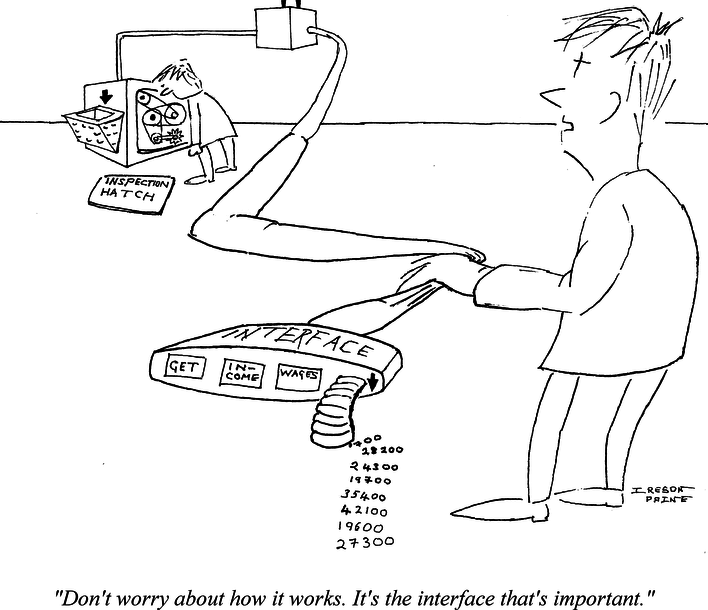
Towards R-Taxben: Reading Parameters
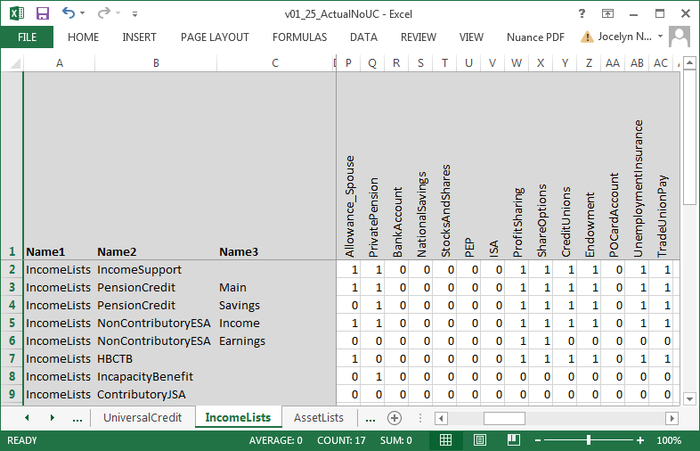
Towards R-Taxben: Reading Parameters II
The model parameters are held in spreadsheets. To
read these, I use the read_excel
function from the Tidyverse "readxl" package. It
handles Excel files directly, without them having to be
converted to CSV.
The function returns a data frame. I have to convert the names in the three columns on the left, so that the rest of the model can ask questions like "What's the value of parameter Savings in PensionCredit in IncomeLists?"
I wrote a function called multinest
for this, which turns the names into a list of
lists of lists. The model could then get at
parameters using
$ and column names, in expressions
like IncomeLists$PensionCredit$Savings .
Towards R-Taxben: Reading Parameters III
But as discussed, an expression like
IncomeLists$PensionCredit$Savings
is fragile. If
I change parameter representation, I'd have to recode it.
So I wrote a function getp, which insulates
its user from the representation. I call it
like this:
getp( IncomeLists, PensionCredit, Savings ) .
If I change the representation, I redefine getp,
and the user should notice no difference.
Towards Program Quality: Experiments

Towards Program Quality: Experiments II
"When you start development, you have an early stage where you need to explore possibilities. ... So you need to experiment to reduce those uncertainties, so you can focus and implement your code. This experimentation process is the Make it Work stage, where you just code to achieve the desired behavior or effect." Quoted earlier under Representation-Independent Selectors, abridged from http://henriquebastos.net/the-make-it-work-make-it-right-make-it-fast-misconception/ .
I keep my experiments, commented so that I and others can read them easily. Because they may be useful later. As we'll see, I also blog some of them.
Towards Program Quality: Readable Code
# Returns a family_type. See the
# family_type document.
# age_2 and sex_2 are only defined
# if is_couple .
#
family_type <- function( age_1, sex_1
, age_2, sex_2
, is_couple
, num_children
)
{
ad1_is_pensioner <- of_pensionable_age( age_1, sex_1 )
ad2_is_pensioner <- of_pensionable_age( age_2, sex_2 )
is_single <- !is_couple
case_when(
is_couple & ( ad1_is_pensioner | ad2_is_pensioner ) ~ 'couple_pensioner'
, is_single & ad1_is_pensioner ~ 'single_pensioner'
, is_couple & num_children == 0 ~ 'couple_no_children'
, is_single & num_children == 0 ~ 'single_no_children'
, is_couple & num_children > 0 ~ 'couple_children'
, is_single & num_children > 0 ~ 'single_children'
)
}
Towards Program Quality: Readable Code II
The slide before shows a function that indicates what kind of family a benefit unit contains, for the purposes of their benefits. For example, pensioners receive pensions, so it has to use age to work out whether the adults are pensioners. Children receive child benefit, so it has to say whether the family includes children.
I have tried to make this as readable as possible. That's essential for maintenance, especially when the code is handling complicated things. Like the UK benefits system.
A Reference Standard for UK Benefits
The UK benefits system is notoriously opaque. This helps the Government save money, by making it harder to understand what you can claim. But although the Government has no interest in clarity, organisations that help claimants do. For example, the Childhood Poverty Action Group publishes its Welfare Benefits and Tax Credits Handbook: "an essential resource for all professional advisers serious about giving the best and most accurate advice to their clients".
It would be great if R-Taxben could become accepted as a reference standard for the benefits system, against which interpretations of the benefits rules could be tested: an electronic Handbook. We think this is feasible. It will require our code to be very very readable.
Towards Program Quality: Testing
# test_utilities.R
#
# Test the functions in utilities.R
library( testthat )
source( 'utilities.R' )
test_that( "year_and_month_to_tax_year() works", {
expect_that( year_and_month_to_tax_year( 1990, 1 ), equals("1989-90") )
expect_that( year_and_month_to_tax_year( 1990, 3 ), equals("1989-90") )
expect_that( year_and_month_to_tax_year( 1990, 4 ), equals("1990-91") )
expect_that( year_and_month_to_tax_year( 1990, 12 ), equals("1990-91") )
expect_that( year_and_month_to_tax_year( 2001, 1 ), equals("2000-01") )
expect_that( year_and_month_to_tax_year( 2001, 3 ), equals("2000-01") )
expect_that( year_and_month_to_tax_year( 2001, 4 ), equals("2001-02") )
expect_that( year_and_month_to_tax_year( 2001, 12 ), equals("2001-02") )
expect_that( year_and_month_to_tax_year( 2000, 1 ), equals("1999-00") )
expect_that( year_and_month_to_tax_year( 2000, 3 ), equals("1999-00") )
expect_that( year_and_month_to_tax_year( 2000, 4 ), equals("2000-01") )
expect_that( year_and_month_to_tax_year( 2000, 12 ), equals("2000-01") )
#
# I don't know what Howard would like returned
# for the tax year 1999-2000. This is my
# interpretation.
expect_that( year_and_month_to_tax_year( 1999, 1 ), equals("1998-99") )
expect_that( year_and_month_to_tax_year( 1999, 3 ), equals("1998-99") )
expect_that( year_and_month_to_tax_year( 1999, 4 ), equals("1999-00") )
expect_that( year_and_month_to_tax_year( 1999, 12 ), equals("1999-00") )
})
Towards Program Quality: Testing II
# test_read_params_from_excel.R
#
# Tests params_read_table_from_excel().
library(tidyverse)
library(testthat)
source( 'read_params_from_excel.R' )
test_that( "Reads a parameter sheet and returns the expected
contents, checked in detail", {
t <- params_read_table_from_excel(
'tests/data/v01_25_ActualNoUC.xlsx', 'CouncilTax' )
expect_that( nrow(t), equals(24) )
expect_that( ncol(t), equals(32) )
expect_that( names(t)[[4]], equals('Uprating') )
years <- 2003:2030
year_names <- str_c( years, "-", str_sub( years+1, 3, 4 ) )
# What the names should be: 2003-04 to 2030-31.
expect_that( names(t)[5:ncol(t)], equals(year_names) )
expect_that( unique(t[[1]]), equals("CouncilTax") )
expect_that( unique(t[1:3,2][[1]]), equals("Multiplier") )
expect_that( unique(t[4:12,2][[1]]), equals("BandMultiplier")
)
expect_that( unique(t[13:24,2][[1]]), equals("BandDAverage") )
expect_that( unique(str_sub(unlist(t[4:12,3]),1,4)),
equals("Band") )
expect_that( t[[24,3]], equals("NI") )
expect_that( unique(t[4:12,4][[1]]), equals("Repeat") )
expect_that( unique(t[13:23,4][[1]]), equals("0.04") )
# Although Excel displays it as 4.0%.
expect_that( t[[24,4]], equals("PrevSep.CPI.AnnualGrowth") )
expect_that( unique(t[3,5:31][[1]]), equals(0.75,tolerance=0.000001) )
expect_that( unique(t[11,5:31][[1]]), equals(2.0,tolerance=0.000001) )
expect_that( t[[24,32]], equals(1192.03,tolerance=0.000001) )
})
test_that( "Reads all the parameter sheets and passes them as
valid", {
param_sheetnames <-
c("General", "IncomeTax", "NICs",
"VAT", "Excise", "OtherIndirect"
,"CouncilTax", "IncomeSupport",
"HBCTB", "PensionCredit", "CitizensIncome"
,"IncapacityBenefit", "ESA",
"OtherDisabilityBenefits", "ChildBenefit"
,"OtherNonMTBenefits", "Winter Fuel",
"TaxCredits", "UniversalCredit"
)
param_sheetnames <- setdiff( param_sheetnames, "VAT" )
#
# The VAT sheet has a bad column heading for
# 1999-2000, presumably caused by someone
# misprogramming the millennium change, so I've
# removed its name from the above. All the rest
# should be parameter sheets in the expected
# format.
for ( sheetname in param_sheetnames ) {
t <- params_read_table_from_excel(
'tests/data/v01_25_ActualNoUC.xlsx', sheetname )
warnings <- attributes( t )$validation
expect_that( warnings, equals( c() ) )
}
})
# Used below to shorten the tests that check
# validation of faulty worksheets.
#
test_validation_failure <- function( title, filename, message )
{
test_that( title, {
t <- params_read_table_from_excel( filename, 'CouncilTax' )
warnings <- attributes( t )$validation
expect_that( length(warnings), equals(1) )
expect_that( warnings[[1]], equals(message) )
})
}
test_validation_failure( "Detects bad year-column names in parameter
sheet (I)"
,
'tests/data/v01_25_ActualNoUC_bad_year_colname_I.xlsx'
, 'Columns 8 onwards are all expected to be headed
by year numbers such as 2003-04.'
)
# First year column name is 2003-EE.
test_validation_failure( "Detects bad year-column names in parameter
sheet (II)"
,
'tests/data/v01_25_ActualNoUC_bad_year_colname_II.xlsx'
, 'Columns 8 onwards are all expected to be headed
by year numbers such as 2003-04.'
)
# Final year column name is EE.
test_validation_failure( "Detects bad 'Name' column name in parameter
sheet"
,
'tests/data/v01_25_ActualNoUC_bad_name_colname.xlsx'
, "Columns 4, 5, 6 and 7 are expected to be
headed 'Name', 'Uprating', 'Worksheet', and 'Lookup'."
)
# Column name is EE.
test_validation_failure( "Detects bad 'Uprating' column name in
parameter sheet"
,
'tests/data/v01_25_ActualNoUC_bad_uprating_colname.xlsx'
, "Columns 4, 5, 6 and 7 are expected to be
headed 'Name', 'Uprating', 'Worksheet', and 'Lookup'."
)
# Column name is EE.
test_validation_failure( "Detects bad 'Worksheet' column name in
parameter sheet"
,
'tests/data/v01_25_ActualNoUC_bad_worksheet_colname.xlsx'
, "Columns 4, 5, 6 and 7 are expected to be
headed 'Name', 'Uprating', 'Worksheet', and 'Lookup'."
)
# Column name is EE.
test_validation_failure( "Detects bad 'Lookup' column name in
parameter sheet"
,
'tests/data/v01_25_ActualNoUC_bad_lookup_colname.xlsx'
, "Columns 4, 5, 6 and 7 are expected to be
headed 'Name', 'Uprating', 'Worksheet', and 'Lookup'."
)
# Column name is EE.
test_validation_failure( "Detects non-empty rows under column names
in parameter sheet (I)"
,
'tests/data/v01_25_ActualNoUC_rows_under_colnames_not_blank_I.xlsx'
, "The second two rows of columns 1:3 are
expected to be empty."
)
# Top-left cell is EE.
test_validation_failure( "Detects non-empty rows under column names
in parameter sheet (II)"
,
'tests/data/v01_25_ActualNoUC_rows_under_colnames_not_blank_I.xlsx'
, "The second two rows of columns 1:3 are
expected to be empty."
)
# Bottom-right cell is EE.
test_validation_failure( "Detects bad cell in first names column in
parameter sheet (I)"
,
'tests/data/v01_25_ActualNoUC_bad_col1_name_cell_I.xlsx'
, "Rows 4 onwards of column 1 are expected to
be parameter names."
)
# First cell is blank.
test_validation_failure( "Detects bad cell in first names column in
parameter sheet (II)"
,
'tests/data/v01_25_ActualNoUC_bad_col1_name_cell_II.xlsx'
, "Rows 4 onwards of column 1 are expected to
be parameter names."
)
# Final cell is blank.
test_validation_failure( "Detects bad cell in first names column in
parameter sheet (III)"
,
'tests/data/v01_25_ActualNoUC_bad_col1_name_cell_III.xlsx'
, "Rows 4 onwards of column 1 are expected to
be parameter names."
)
# Final cell is a number.
test_validation_failure( "Detects bad cell in second names column in
parameter sheet (I)"
,
'tests/data/v01_25_ActualNoUC_bad_col2_name_cell_I.xlsx'
, "Rows 4 onwards of column 2 are expected to
be parameter names or empty."
)
# First cell is a number.
test_validation_failure( "Detects bad cell in second names column in
parameter sheet (II)"
,
'tests/data/v01_25_ActualNoUC_bad_col2_name_cell_II.xlsx'
, "Rows 4 onwards of column 2 are expected to
be parameter names or empty."
)
# Final cell ends in '#'.
test_validation_failure( "Detects bad cell in third names column in
parameter sheet (I)"
,
'tests/data/v01_25_ActualNoUC_bad_col3_name_cell_I.xlsx'
, "Rows 4 onwards of column 3 are expected to
be parameter names or empty."
)
# First cell is 'Gener@l'.
test_validation_failure( "Detects bad cell in third names column in
parameter sheet (II)"
,
'tests/data/v01_25_ActualNoUC_bad_col3_name_cell_II.xlsx'
, "Rows 4 onwards of column 3 are expected to
be parameter names or empty."
)
# Final cell is 'N I'.
test_that( "The params_string_matches_year() function works", {
expect_that( params_string_matches_year(''), is_false() )
expect_that( params_string_matches_year('EE'), is_false() )
expect_that( params_string_matches_year('2003'), is_false() )
expect_that( params_string_matches_year('2003-'), is_false() )
expect_that( params_string_matches_year('2003-EE'), is_false() )
expect_that( params_string_matches_year('2003-0E'), is_false() )
expect_that( params_string_matches_year('2003-04'), is_true() )
})
test_that( "The params_string_matches_year() function is
vectorised", {
v <- c( '', 'EE', '2003', '2003-04', '2011-12', '2012-1E' )
expected <- c( FALSE, FALSE, FALSE, TRUE, TRUE, FALSE )
expect_that( params_string_matches_year(v), equals(expected) )
})
Towards Program Quality: Testing III
# test_benefits_to_incomes.R
#
# Test benefits_to_incomes().
library( tidyverse )
library( testthat )
source( 'functions_to_help_with_testing.R' )
source( 'benefits_to_incomes.R' )
source( 'read_frs_data_from_csv.R' )
source( 'benefit_types.R' )
test_that( "benefits_to_incomes() works", {
benefits <- read_frs_benefits_from_csv(
"data/FRS201415AllData/benefits.csv" )
incomes <- benefits_to_incomes( benefits )
tol <- 1e-3
# Test final serial number. We don't
# necessarily use all the records, so this
# may be less than the final serial number
# in the original data.
expect_lte( tail(incomes,1)$sernum, 19535 )
# Test that after's serial numbers are a
# subset of before's.
expect_true( all( unique(incomes$sernum) %in% unique(benefits$SERNUM) )
)
# Test that there is only one record
# for each sernum/persnum combination.
# benefits_to_incomes() aggregates
# over all benefit records for the
# same person, so should ensure that.
expect_equal( incomes %>% group_by( sernum, persnum ) %>%
tally() %>%
`$`( n ) %>%
unique()
, 1
)
# Test column names.
expect_equal( names(incomes)
, c( 'sernum', 'persnum', benefit_types() )
)
# Test contents of benefit-type cells.
expect_equal( at_sernum( incomes, 1, child_benefit )
, 47.6, tolerance=tol
)
expect_equal( at_sernum( incomes, 1, child_tax_credit )
, 40.055, tolerance=tol
)
expect_equal( at_sernum( incomes, 1, pip_care )
, 0
)
# 0 because there was no record for it,
# but there were others for other
# benefit types for this person.
expect_equal( at_sernum( incomes, 3, retirement_pension )
, 125.9041096, tolerance=tol
)
expect_equal( at_sernum( incomes, 3, winter_fuel_payment )
, 150, tolerance=tol
)
expect_equal( at_sernum( incomes, 3, last_6m_child_maintenance )
, 0
)
# 0 because there was no record for it,
# but there were others for other
# benefit types for this person.
expect_equal( at_sernum( incomes, 3, retirement_pension )
, 125.9041096, tolerance=tol
)
expect_equal( at_sernum( incomes, 3, winter_fuel_payment )
, 150, tolerance=tol
)
expect_equal( at_sernum( incomes, 3, retirement_pension, 2 )
, 67.8136986, tolerance=tol
)
expect_equal( at_sernum( incomes, 3, winter_fuel_payment, 2 )
, 150, tolerance=tol
)
expect_equal( at_sernum( incomes, 3, guardians_allowance, 2 )
, 0
)
# 0 because there was no record for it,
# but there were others for other
# benefit types for this person.
})
Towards Program Quality: Testing IV
test_that( "family_type() works", {
expect_that( family_type( 59, 'male', NA, NA, FALSE, 0 )
, equals('single_no_children')
)
expect_that( family_type( 59, 'female', NA, NA, FALSE, 0 )
, equals('single_no_children')
)
expect_that( family_type( 59, 'male', NA, NA, FALSE, 1 )
, equals('single_children')
)
expect_that( family_type( 59, 'female', NA, NA, FALSE, 1 )
, equals('single_children')
)
expect_that( family_type( 60, 'male', NA, NA, FALSE, 0 )
, equals('single_no_children')
)
expect_that( family_type( 60, 'female', NA, NA, FALSE, 0 )
, equals('single_pensioner')
)
expect_that( family_type( 60, 'male', NA, NA, FALSE, 1 )
, equals('single_children')
)
expect_that( family_type( 60, 'female', NA, NA, FALSE, 1 )
, equals('single_pensioner')
)
expect_that( family_type( 64, 'male', NA, NA, FALSE, 0 )
, equals('single_no_children')
)
expect_that( family_type( 64, 'female', NA, NA, FALSE, 0 )
, equals('single_pensioner')
)
expect_that( family_type( 64, 'male', NA, NA, FALSE, 1 )
, equals('single_children')
)
expect_that( family_type( 64, 'female', NA, NA, FALSE, 1 )
, equals('single_pensioner')
)
expect_that( family_type( 65, 'male', NA, NA, FALSE, 0 )
, equals('single_pensioner')
)
expect_that( family_type( 65, 'female', NA, NA, FALSE, 0 )
, equals('single_pensioner')
)
expect_that( family_type( 65, 'male', NA, NA, FALSE, 1 )
, equals('single_pensioner')
)
expect_that( family_type( 65, 'female', NA, NA, FALSE, 1 )
, equals('single_pensioner')
)
expect_that( family_type( 59, 'male', 59, 'female', TRUE, 0 )
, equals('couple_no_children')
)
expect_that( family_type( 59, 'female', 59, 'male', TRUE, 0 )
, equals('couple_no_children')
)
expect_that( family_type( 59, 'male', 59, 'female', TRUE, 1 )
, equals('couple_children')
)
expect_that( family_type( 59, 'female', 59, 'male', TRUE, 1 )
, equals('couple_children')
)
expect_that( family_type( 60, 'male', 60, 'female', TRUE, 0 )
, equals('couple_pensioner')
)
expect_that( family_type( 60, 'female', 60, 'male', TRUE, 0 )
, equals('couple_pensioner')
)
expect_that( family_type( 60, 'male', 60, 'female', TRUE, 1 )
, equals('couple_pensioner')
)
expect_that( family_type( 60, 'female', 60, 'male', TRUE, 1 )
, equals('couple_pensioner')
)
expect_that( family_type( 60, 'male', 59, 'female', TRUE, 0 )
, equals('couple_no_children')
)
expect_that( family_type( 59, 'female', 60, 'male', TRUE, 0 )
, equals('couple_no_children')
)
expect_that( family_type( 60, 'male', 59, 'female', TRUE, 1 )
, equals('couple_children')
)
expect_that( family_type( 59, 'female', 60, 'male', TRUE, 1 )
, equals('couple_children')
)
expect_that( family_type( 65, 'male', 59, 'female', TRUE, 0 )
, equals('couple_pensioner')
)
expect_that( family_type( 59, 'female', 65, 'male', TRUE, 0 )
, equals('couple_pensioner')
)
expect_that( family_type( 65, 'male', 59, 'female', TRUE, 1 )
, equals('couple_pensioner')
)
expect_that( family_type( 59, 'female', 65, 'male', TRUE, 1 )
, equals('couple_pensioner')
)
expect_that( family_type( 65, 'male', 65, 'female', TRUE, 0 )
, equals('couple_pensioner')
)
expect_that( family_type( 65, 'female', 65, 'male', TRUE, 0 )
, equals('couple_pensioner')
)
expect_that( family_type( 65, 'male', 65, 'female', TRUE, 1 )
, equals('couple_pensioner')
)
expect_that( family_type( 65, 'female', 65, 'male', TRUE, 1 )
, equals('couple_pensioner')
)
})
test_that( "of_pensionable_age() works", {
expect_that( of_pensionable_age( 1, 'male' ), is_false() )
expect_that( of_pensionable_age( 1, 'female' ), is_false() )
expect_that( of_pensionable_age( 20, 'male' ), is_false() )
expect_that( of_pensionable_age( 20, 'female' ), is_false() )
expect_that( of_pensionable_age( 59, 'male' ), is_false() )
expect_that( of_pensionable_age( 59, 'female' ), is_false() )
expect_that( of_pensionable_age( 60, 'male' ), is_false() )
expect_that( of_pensionable_age( 60, 'female' ), is_true() )
expect_that( of_pensionable_age( 64, 'male' ), is_false() )
expect_that( of_pensionable_age( 64, 'female' ), is_true() )
expect_that( of_pensionable_age( 65, 'male' ), is_true() )
expect_that( of_pensionable_age( 65, 'female' ), is_true() )
expect_that( of_pensionable_age( 100, 'male' ), is_true() )
expect_that( of_pensionable_age( 100, 'female' ), is_true() )
})
Towards Program Quality: Testing V
I use the package "testthat" for testing. To use it, you write a collection of function calls or other expressions, each with a statement of what its result should be. The package runs each one and reports an error if its result is not as expected.
Towards Program Quality: Testing VI
The first slide tests the simple function
year_and_month_to_tax_year shown
earlier.
Towards Program Quality: Testing VII
The second slide tests reading parameter spreadsheets. It starts by checking the size of the read data and the contents of cells. It then sees whether it can read all our parameter sheets. Then it checks a collection of erroneous spreadsheets I made, testing that the error messages from each are as expected. Finally, it tests one of the functions used, one for matching against tax years in column headings.
Rigorous testing — for example, preparing all those faulty spreadsheets — is a lot of work!
Towards Program Quality: Testing VIII
The third slide tests conversion of FRS benefits data to incomes. There are some general tests on IDs and data structure, followed by detailed tests on fields in converted records.
In these tests, I had to think about missing data and how it's aggregated. For example, what should the results be if a person has no benefits records at all? What if they have records for some benefits but not for others?
Towards Program Quality: Testing IX
The fourth slide tests the family_type
function and another function it calls, of_pensionable_age.
It needs to test a lot of combinations, of ages above, below, and on
the pension thresholds.
Towards Program Quality: Profiling
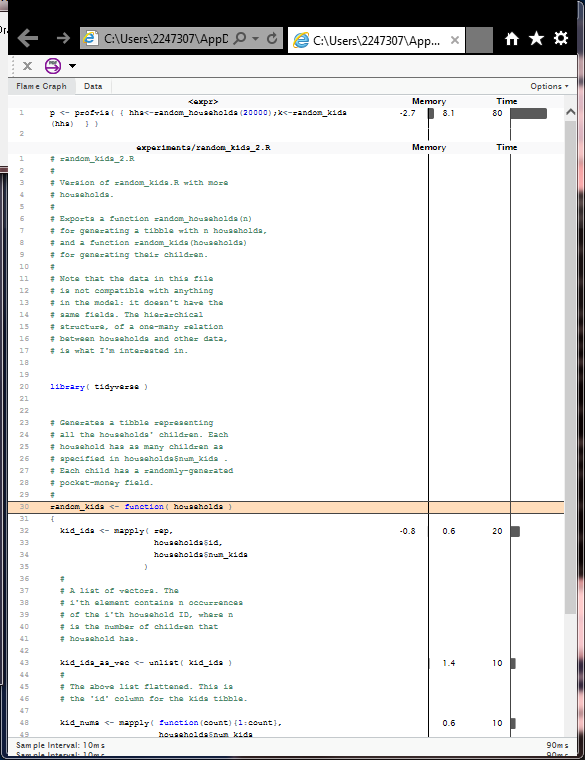
Towards Program Quality: Profiling II
Profilers show time spent or memory used in different regions of a program. They help you focus on the parts that need optimising. The screenshot is a profile output by the "profvis" package. It's for a function I wrote that generates sample children to inhabit households, in order to test using household and people tables together.
Towards Program Quality: Benchmarking

Towards Program Quality: Benchmarking II
Benchmarking tests the performance of code,
often by comparing with alternative versions.
The screenshot is output from the "microbenchmark"
package. It's comparing the times to run
four versions of my function spread_to_list,
called when reading the hierarchical names from
parameter worksheets. Two versions of the function
were much slower than the other two, so I didn't
need to develop them further. The other two were
about the same speed, so it didn't matter
which one I used.
Towards Program Quality: Documentation
I am documenting all the data structures my code uses, with a a web page describing each structure.
This alleviates the problem that in R, any variable can hold any type of data. Unlike e.g. Pascal, which requires every variable to be declared with one and only one type. That type helps the compiler check that wrong kinds of data aren't getting into the variable. It is also useful documentation for the reader. But in R, the compiler can't check, and it's easy to make mistakes. So I need to comment every variable with details of what it holds.
But to avoid writing everything about a type in every comment that refers to it, we need to centralise the information. That's what my documentation pages do.
Towards Program Quality: Documentation II
R has features not found in other languages. Implicit looping over vectors is one. Another is "NA" values, used for when data is missing. We have to consider these when documenting. For a function, we need to say whether it does implicit looping or not. Some don't. For data, we have to say whether it contains NA values, and when, and exactly what they signify. You can see that the latter needs a lot of care.
Towards Program Quality: Blogging
We hope R-Taxben will become open-source, so that people everywhere can collaborate on it. But even if that doesn't happen, it's important to have a record not only of how the code works, but of why it was designed to work that way. I am providing this by blogging about my design.
I could have written just for myself. But blogging keeps me honest, making me explain clearly to other people. It brings R-Taxben to the attention of people who might use it or collaborate. And some posts may help R programmers with other programs.
The next slide lists my posts to date, 14th March 2018. To see all posts, go to http://www.j-paine.org/blog/ and select those categorised under "R".
Towards Program Quality: Blogging II
Two Kinds of Conditional Expression: ifelse(A,B,C) versus if (A) B else C
One out of quite a lot of confusing things about R is that it has two kinds of conditional expression. There’s ifelse(); and there’s the if statement. It’s important to know which one to use, as I found when trying to write a conditional expression that chose between lists. The first thing to appreciate is … Continue reading “Two Kinds of Conditional Expression: ifelse(A,B,C) versus if (A) B else C”
Beat the Delays: installing R and the BH package on a memory stick
I use R on a range of Windows machines. Often, I’ll only use these once, and they won’t already have R. So I want to carry an installation with me. So I decided to install R on a memory stick. Installing R itself worked, once I’d changed the folder on the “Select Destination Location” pop-up. … Continue reading “Beat the Delays: installing R and the BH package on a memory stick”
Experiments with count(), tally(), and summarise(): how to count and sum and list elements of a column in the same call
Most people have a job. Some don’t. And a few have more than one. I’ve mentioned before that our economic model works on data about British households, gathered from surveys such as the Family Resources Survey. Each collection of data is a year long, and contains a file that describes all the adults in the … Continue reading “Experiments with count(), tally(), and summarise(): how to count and sum and list elements of a column in the same call”
Second-Guessing R
I keep doing experiments with R, and with its Tidyverse package, to discover whether these do what I think they’re doing. Am I justified in spending the time? I’ve said before that the Tidyverse follows rather different conventions from those of base R. This is something Bob Muenchen wrote about in “The Tidyverse Curse”. Dare … Continue reading “Second-Guessing R”
Experiments with summarise(); or, when does x=x[[1]]?
Here’s another innocent-eye exploration, this time about the Tidyverse’s summarise() function. I’d been combining data tables by nesting and joining them, which gave me a tibble with nested tibbles in. I wanted to check the sizes of these inner tibbles, by mapping nrow() over the columns containing them. The Tidyverse provides several ways to do … Continue reading “Experiments with summarise(); or, when does x=x[[1]]?”
My Testing Was Hurt By a List With No Names
I spied a strange thing with my innocent eye. I was testing spread_to_list, the function I wrote about in “How Best to Convert a Names-Values Tibble to a Named List?”. One of my tests passed it a zero-row tibble, expecting that the result would be a zero-element list: test_that( “Test on zero-element tibble”, { t … Continue reading “My Testing Was Hurt By a List With No Names”
Multinest: Factoring Out Hierarchical Names by Converting Tibbles to Nested Named Lists
Consider this tibble: vat_rates <- tribble( ~l1, ~l2 , ~l3 , ~val , ‘VAT’, ‘Cigarettes’, ” , ‘standard’ , ‘VAT’, ‘Tobacco’ , ” , ‘standard’ , ‘VAT’, ‘Narcotics’ , ” , 0 , ‘VAT’, ‘Clothing’ , ‘Adult’ , ‘standard’ , ‘VAT’, ‘Clothing’ , ‘Children’ , 0 , ‘VAT’, ‘Clothing’ , ‘Protective’, 0 ) It contains … Continue reading “Multinest: Factoring Out Hierarchical Names by Converting Tibbles to Nested Named Lists”
How Best to Convert a Names-Values Tibble to a Named List?
Here, in the spirit of my “Experiments with by_row()” post, are some experiments in writing and timing a function spread_to_list that converts a two-column tibble such as: x 1 y 2 z 3 t 4 to a named list: list( x=1, y=2, z=3, t=4 ) I need this for processing the parameter sheets shown in … Continue reading “How Best to Convert a Names-Values Tibble to a Named List?”
Experiments with by_row()
I’ve been experimenting with by_row() from the R purrrlyr package. It’s a function that maps over the rows of a data frame, which I thought might be handy for processing our economic model’s parameter files. I didn’t find the documentation for by_row() told me everything I wanted to know, so I made up and ran … Continue reading “Experiments with by_row()”
Abstract Data Types and the Uniform Referent Principle II: why Douglas T. Ross would hate nest(), unnest(), gather() and spread()
In “Abstract Data Types and the Uniform Referent Principle I: why Douglas T. Ross would hate nest(), unnest(), gather() and spread()”, I explained why the notation for interfacing to a data structure should be independent of that structure’s representation. R programmers honour this principle in the same way that bricks hang in the sky. All … Continue reading “Abstract Data Types and the Uniform Referent Principle II: why Douglas T. Ross would hate nest(), unnest(), gather() and spread()”
Abstract Data Types and the Uniform Referent Principle I: why Douglas T. Ross would hate nest(), unnest(), gather() and spread()
“What’s the Uniform Referent Principle?” my colleague asked me on reading my last post. I think I first came across it in Jean Sammet’s famous book Programming Languages: History and Fundamentals. In a description of Douglas Ross’s AED-0 language, she pointed out a feature that she thought particularly noteworthy: the notation for getting information out … Continue reading “Abstract Data Types and the Uniform Referent Principle I: why Douglas T. Ross would hate nest(), unnest(), gather() and spread()”
Thoughts on nest()
I’ve been experimenting with the Tidyverse’s nest function, because it may be useful when, for example, using households together with benefit units. Below are some thoughts that I first posted as a comment to Hadley Wickham’s blog entry “tidyr 0.4.0”. More on this in future posts. First, this is likely to be very useful to … Continue reading “Thoughts on nest()”
Literate Programming, Data-flow Networks, and the Inscrutability of Economic Models
Write programs as if they were mathematical essays, but with code instead of equations. This is “literate programming”, an idea invented by the famous computer scientist Donald Knuth. The quote below is from www.literateprogramming.com , apparently first published by Knuth in “Literate Programming (1984)” in Literate Programming, CSLI, 1992, page 99: I believe that the … Continue reading “Literate Programming, Data-flow Networks, and the Inscrutability of Economic Models”
Viewlets
In my last post, I said that I’d arranged for the nodes in my network diagram to be clickable. Clicking on a data node brings up a display showing its contents plus an explanation thereof; clicking on a transformation node shows the code it runs and an explanation of that. I call these little displays … Continue reading “Viewlets”
A Web Interface for Accessing Intermediate Results in R, Using Network Graphs with vis.js
My title says it all. I wanted to give those running our model, myself included, a way to visualise how it works, and to access and check intermediate results. At the top level, the model consists of a few rather large functions sending chunks of data from one to another. These chunks are not conceptually … Continue reading “A Web Interface for Accessing Intermediate Results in R, Using Network Graphs with vis.js”
Implementing Key-Value Notation for Data Frames without Using Tribbles
There’s a lot to be said for tribbles. As Hadley Wickham says in the “Tibbles” chapter of R for Data Science, his tribble function makes it easy to enter small data tables in a program, because you can type them row by row rather than column by column. Like this: tribble( ~actor , ~character, “Shatner”, … Continue reading “Implementing Key-Value Notation for Data Frames without Using Tribbles”
Random Benefit Units for Households II: Generating the Number of Subrows
In my previous post, I assumed my household data would give me the number of children each household has. But suppose I had to generate those numbers too? This is just a note to say that one can do this using the base-R function sample.int . If I understand its documentation correctly, then the call … Continue reading “Random Benefit Units for Households II: Generating the Number of Subrows”
Random Benefit Units for Households I: Generating Random Subrows of a Row
The data for our economic model comes from records representing the income and expenditure of British households. However, the structure isn’t as simple as just one row per household. This is because it’s necessary to split households into “benefit units”: the word “benefit” here refering to the money the State gives you when you’re ill, … Continue reading “Random Benefit Units for Households I: Generating Random Subrows of a Row”
From Python Dictionaries to Tribbles II: How I Implemented Lookup Tables in R for Numeric Data Codes
In my last post, I explained how tribbles make it easy to write data frames as a sequence of key-value pairs. But how can I make these data frames act as lookup tables? By using the base R function match. This is how it works. First, I’ll make a tibble: dict <- tribble( ~key, ~value, … Continue reading “From Python Dictionaries to Tribbles II: How I Implemented Lookup Tables in R for Numeric Data Codes”
From Python Dictionaries to Tribbles I: How I Implemented Lookup Tables in R for Numeric Data Codes
As regular readers will know, I’ve been translating an economic model from Python into R. It reads data about the income and expenditure of British households, from sources such as the Family Resources Survey and Family Expenditure Survey . Much of this data is coded as numbers, and the model has to translate these into … Continue reading “From Python Dictionaries to Tribbles I: How I Implemented Lookup Tables in R for Numeric Data Codes”
Reification
We programmers live our working lives surrounded by data structures and subroutines, entities that become as concrete to us — as “thing-like”, as “manipulable” — as teacups and bricks. The feeling of thingness is strengthened, I think, by interactive shells such as R’s which enable one to call functions and inspect their results, and to … Continue reading “Reification”
The Innocent Eye, the Martian Poet, and the R Inferno
Literature has the concept of the “innocent eye”: that visitor to regions strange who, vision unclouded by familiarity, is able to see and report on how absurd things really are over there. There are also “Martian poets”, who send home postcards about the oddities of their own environment as if visiting it from Mars. As … Continue reading “The Innocent Eye, the Martian Poet, and the R Inferno”
Which Symbol Should I Use for Assignment?
Perhaps I should add to my post about FreeFormatter. I noted that manual conversion of R code for inclusion in web pages is a pain because of the assignment symbol, <-. But I feel I should say that assignment can also be written as =, though this sometimes clashes with = for named function arguments. … Continue reading “Which Symbol Should I Use for Assignment?”
FreeFormatter: Escaping R Code for HTML
My demo of spreading and gathering data, like all my blog posts, is written in HTML. To prevent < and > symbols in my code messing this up, I had to “escape” them by rewriting them as < and >. This is more of a pain in R than in many other languages, because of … Continue reading “FreeFormatter: Escaping R Code for HTML”
Demonstrating spread() and gather()
In my last post about R, I said I was translating an economic model from Python into R. It’s a microeconomic model, meaning that it simulates the behaviour of individual people rather than bulk quantities such as inflation and unemployment. The simulator uses data about the income and expenditure of British households, from sources such … Continue reading “Demonstrating spread() and gather()”
Should I Use the Tidyverse?
I’m doing a lot of programming in the statistics language R, as I translate an economic model into R from Python. This is a big project, and I’ll blog about it more in later posts, as I share useful bits of code I’ve written. But in this post, I want to mention a kind of … Continue reading “Should I Use the Tidyverse?”
A Web Interface
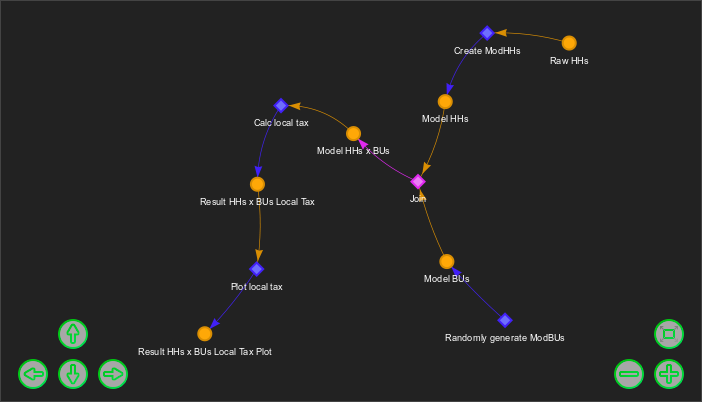
A Web Interface II: Viewing Data

A Web Interface III: Viewing Code
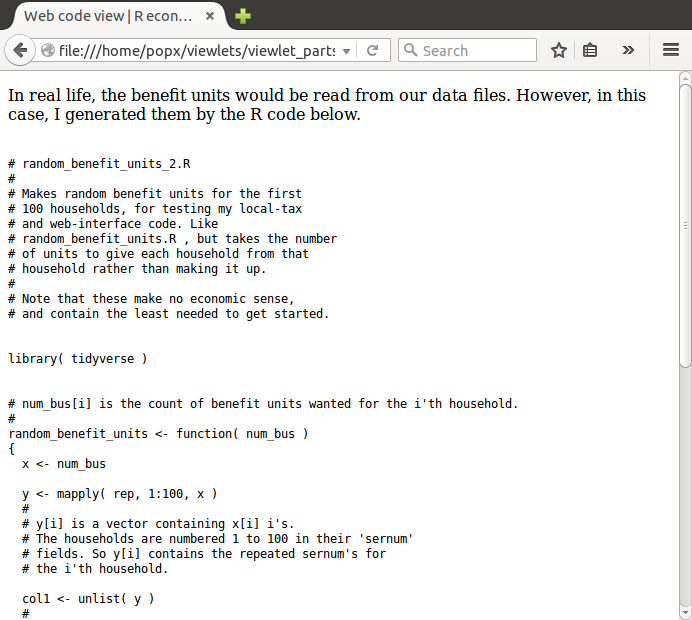
A Web Interface IV: Non-inscrutability
R can be run from a web server. The previous three slides show my web interface, built in Almende's Vis.js visualisation library. The first slide is a network showing top-level functions (in an older version of the model) as diamonds, and results as circles. Lines show how data flows between functions. By clicking on a circle, the user can view the data; by clicking on an arrow, the function code. Because data is just tables, it's easy to understand.
It is essential that users can see how R-Taxben works. Traditionally, economic models have been opaque, their assumptions known only to the few who implemented them. As we've seen, R programmers can probe the data using R. But with this display, even the non-programmers are free to peer inside.
The End
